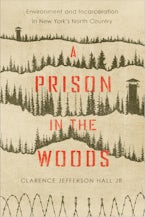- Home
- Environmental History of the Northeast
- A Prison in the Woods

A Prison in the Woods
Environment and Incarceration in New York's North Country
Published by: University of Massachusetts Press
Series: Environmental History of the Northeast
288 Pages, 6.00 x 9.00 x 0.90 in, 11 b&w illus., 3 maps
Other Retailers:
Since the mid-nineteenth century, Americans have known the Adirondack Mountains of upstate New York as a site of industrial production, a place to heal from disease, and a sprawling outdoor playground that must be preserved in its wild state. Less well known, however, has been the area's role in hosting a network of state and federal prisons. A Prison in the Woods traces the planning, construction, and operation of penitentiaries in five Adirondack Park communities from the 1840s through the early 2000s to demonstrate that the histories of mass incarceration and environmental consciousness are interconnected.
Clarence Jefferson Hall Jr. reveals that the introduction of correctional facilities—especially in the last three decades of the twentieth century—unearthed long-standing conflicts over the proper uses of Adirondack nature, particularly since these sites have contributed to deforestation, pollution, and habitat decline, even as they've provided jobs and spurred economic growth. Additionally, prison plans have challenged individuals' commitment to environmental protection, tested the strength of environmental regulations, endangered environmental and public health, and exposed tensions around race, class, place, and belonging in the isolated prison towns of America's largest state park.
Clarence Jefferson Hall Jr. reveals that the introduction of correctional facilities—especially in the last three decades of the twentieth century—unearthed long-standing conflicts over the proper uses of Adirondack nature, particularly since these sites have contributed to deforestation, pollution, and habitat decline, even as they've provided jobs and spurred economic growth. Additionally, prison plans have challenged individuals' commitment to environmental protection, tested the strength of environmental regulations, endangered environmental and public health, and exposed tensions around race, class, place, and belonging in the isolated prison towns of America's largest state park.
CLARENCE JEFFERSON HALL JR. is assistant professor of history at Queensborough Community College.
"This is a pivotal study in the history of carceral systems in the United States. Hall brings together two seemingly dissimilar developments in the Adirondack region—prison development and the rise of environmental consciousness—and in the process adds significantly to our understanding of prison history."—Richard W. Judd, author of Second Nature: An Environmental History of New England
"With an engaging narrative, Hall draws on important scholarship from the field of carceral history as well as relevant environmental literature to make a persuasive case that two topics that might seem unrelated—prison construction and operation and the environment—are actually inextricably intertwined."—David Soll, author of Empire of Water: An Environmental and Political History of the New York City Water Supply
"[T]he spectacular scholarship of A Prison in the Woods is . . . essential. It is more than a historical monument, plaque, or testament; it is also a ledger of the debts incurred by racism and mass incarceration in New York’s North Country."—H-Net Reviews
"Hall looks at the development of America’s carceral system from perspectives that few scholars have used . . . in this impressive book.”—Journal of American History
"This is a pivotal study in the history of carceral systems in the United States. Hall brings together two seemingly dissimilar developments in the Adirondack region—prison development and the rise of environmental consciousness—and in the process adds significantly to our understanding of prison history."—Richard W. Judd, author of Second Nature: An Environmental History of New England
"With an engaging narrative, Hall draws on important scholarship from the field of carceral history as well as relevant environmental literature to make a persuasive case that two topics that might seem unrelated—prison construction and operation and the environment—are actually inextricably intertwined."—David Soll, author of Empire of Water: An Environmental and Political History of the New York City Water Supply
"[T]he spectacular scholarship of A Prison in the Woods is . . . essential. It is more than a historical monument, plaque, or testament; it is also a ledger of the debts incurred by racism and mass incarceration in New York’s North Country."—H-Net Reviews
"Hall looks at the development of America’s carceral system from perspectives that few scholars have used . . . in this impressive book.”—Journal of American History
"Especially welcome is Hall’s attention to environmental impacts, local geographical character, the complexities of issues, and rival approaches to the problems of criminal incarceration . . . While Hall is an historian, his discussions can appeal to geographers, planners, sociologists, and many others."—The Pennsylvania Geographer











